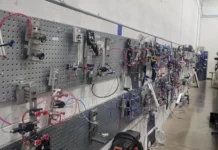by Chris Nomura, consultant/trainer
RJG, Inc.
Anyone who has been through RJG training is familiar with the concept of the Four Plastics Variables. The Four Plastics Variables (4PVs) are a way of breaking the process down into four components to help understand what is actually affecting part quality, separate from machine settings.
Our natural inclination is to look at the process from the perspective of machine settings. If you look at most setup sheets, you will see things such as barrel temperature, injection speed or mold heater temperature. Looking on page 54, you will see that our setup sheet is very different.
What we want to focus on are the variables that actually affect the part. If we do that, we should be able to replicate that process on any machine on any day. Making one good part is relatively easy, but making thousands or millions is a bit more challenging. When things go wrong, we need to ask ourselves, What changed?

To determine what’s changed in our process, we are going to look at each of the 4PVs (see Chart 1).
Our first plastic variable is perhaps the simplest to understand – temperature. The question we are going to ask ourselves is, “How hot is it?” with “it” being the plastic. If it’s too hot, we will cool it down; if it’s too cold, we will heat it up. Several machine variables can be used to create that change, but as long as we get the temperature back to where it should be without changing the other three variables, we should be all right.
Next comes flow. Flow is a bit trickier than temperature in that we have two questions we must answer.
1. How much plastic are we moving?
2. How fast are we moving it?
To determine how much we are moving, first we will remove pack and hold and then weigh a short shot. This tells us how much plastic we are injecting into the mold during the flow portion of the process. If we are moving too much or too little, we can adjust the amount by changing our shot size and/or transfer position.
Our actual speed is indicated by the fill time. Much like how a police officer doesn’t care what you read on your speedometer, we don’t focus on the injection speed setting – rather, we want to see how long it actually took to get from point A to point B. That’s the fill time.
Once flow is over, the plastic begins to enter the packing or pressure part of the process. Notice a trend? The 4PVs are in the order that the plastic itself undergoes in the process. It is essential that we check the variables in this order so we do not affect earlier parts of the process as we go down the list of questions.
Two questions should be asked regarding pressure:
1. How hard are we packing and holding?
2. For how long?

Answering how long we are packing and holding is just a function of the pack and/or hold timer, but to determine how hard we are actually packing, we need to know the intensification ratio of the machine – or the ratio between the hydraulic pressure setting on the machine – and the pressure the plastic actually experiences. Intensification ratios vary dramatically, and without knowing our particular machine’s intensification ratio, we have no idea how “hard” we are actually packing it out.
Other variables that may affect actual plastic pressure include mold deflection or check-ring leakage. Without an instrumented mold, we are not able to confirm with absolute certainty that the pressure in the mold is the same. Helping to verify these kinds of questions is one of the major advantages of instrumented molding.
Last, we come to cooling – ironically, often the most overlooked plastic variable. It is ironic because cooling typically makes up at least 60 percent of our total cycle time.
Again, we have two questions to answer.
1. How fast are we cooling it?
2. For how long?
As with pressure, “For how long?” is relatively straightforward to answer – we just look at actual cooling, take out and cycle times, and verify that they havent changed. Remember that from the plastic’s point of view, cooling continues until the entire part has reached room temperature. This may take hours for thick wall parts collected in a gaylord.
The two variables that affect cooling rate are plastic temperature and mold temperature; the greater the distance between the two, the faster the plastic will cool. We’ve already verified our plastic temperature back in question number 1, but mold temperature also will have to be checked.
The best way of doing this is by measuring steel temperature directly from the mold or measuring part surface temperature after ejection and comparing these numbers to values that we recorded when we initially created the process. If we observe a change, it’s time to look at things like actual water temperature, mold cleanliness, condition of water lines and passages, etc.

If we come to the end of our seven questions (see Chart 2) and we have proven that the process is the same as before, but that the parts are still different, the problem must lie somewhere else: perhaps with the mold or the material itself. At the very least, if we can answer these seven questions, then we’ve been able to systematically eliminate the process itself as the source of our variation.
A systematic way of finding changes is the first step to moving away from the “finger-pointing” that plagues far too many shops and moving toward a focus on finding solutions.
Chris Nomura is an RJG consultant/trainer. He is a certified Master MolderSM and is qualified to teach Scientific and DECOUPLED MOLDINGSM methodologies and techniques. For more information, visit www.rjginc.com.




